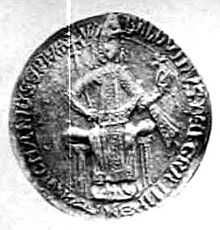Baldwin II of Constantinople

Baldwin II of Courtenay (French: Baudouin II de Courtenay) (late 1217 – October 1273) was the last emperor of the Latin Empire of Constantinople.
He was born in Constantinople, a younger son of Yolanda of Flanders, sister of the first two emperors, Baldwin I and Henry of Flanders. Her husband, Peter of Courtenay, was third emperor of the Latin Empire (also known as Romania, not to be confused with modern Romania), and had been followed by his son Robert of Courtenay, on whose death in 1228 the succession passed to Baldwin, then an 11-year-old boy.
The barons chose John of Brienne (titular king of the Kingdom of Jerusalem) as emperor-regent for life; Baldwin was to rule the Asiatic possessions of the empire when he reached the age of twenty. He was also to marry Marie of Brienne, daughter of John and his third wife Berenguela of Leon, and on John's death to enjoy the full imperial sovereignty. The marriage contract was carried out in 1234. Since the death of Baldwin's uncle, Emperor Henry of Flanders in 1216, the Latin Empire had declined and the Byzantine (Nicene) power advanced; and the hopes that John of Brienne might restore it were disappointed.
The realm Baldwin governed was little more than the city of Constantinople. His financial situation was desperate, and his life was chiefly occupied in begging at European courts. He went to the West in 1236, visited Rome, France and Flanders, trying to raise money and men to recover the lost territory of his realm. In 1237, with the support of the King of France and the Countess of Flanders, he chased his sister Margaret from power to become the next Count of Namur. But Baldwin was practically never present, and after the invasion and conquest of Namur by Henry V, Count of Luxembourg in 1256, he sold the rights on the County to his cousin Guy, Count of Flanders.
In 1237, Baldwin II pawned the Crown of Thorns to a Venetian merchant for 13,134 gold pieces. His efforts met with success, and in 1240 he returned to Constantinople (through Germany and Hungary) at the head of a considerable army. Circumstances hindered him from accomplishing anything with this help, and in 1245 he traveled again to the West, first to Italy and then to France, where he spent two years. The empress Marie and Philip of Toucy governed during his absence. He was happy to be able to get money from King Louis IX in exchange for relics. In 1249 he was with King Louis at Damietta.
| Capetian dynasty Cadets |
|---|
The extremity of his financial straits reduced him soon afterwards to handing over his only son, Philip, to Venetian merchants as a pledge for loans of money. Philip was later redeemed by Alfonso X of Castile. The rest of his reign was spent by Baldwin in mendicant tours in western Europe.
On the night of 24 July 1261, a group of soldiers under Alexios Strategopoulos managed to enter Constantinople through a secret passageway and captured the city. Baldwin was asleep in the Blachernae Palace when the noise of the fighting awoke him; upon seeing the Byzantine troops advance upon him, he fled in such haste that he left his crown and sceptre behind him. Baldwin made his way to the harbor where he boarded a Venetian galley to Negropont.[1] From there he proceeded to Athens, thence to Apulia, finally to France. As titular emperor, his role was still the same, to beg help from the western powers. In 1267 he went to Italy; his hopes were centred on Charles of Anjou. Charles seriously entertained the idea of conquering Constantinople, though his efforts were destroyed during the Sicilian Vespers, an event perhaps engineered by Michael VIII Palaeologus of Constantinople. To this intent, he signed the Treaty of Viterbo with Baldwin (May 1267). During the next year Baldwin and his son Philip lived on pensions from Charles. In October 1273 Philip married Beatrice, daughter of Charles, at Foggia. A few days later Baldwin died in Naples. Under Baldwin II, Constantinople's population had fallen to a mere 35,000 people.
References
- ↑ Donald M. Nicol, The Last Centuries of Byzantium 1261–1453, second edition (Cambridge: University Press, 1993), p. 35
 Chisholm, Hugh, ed. (1911). "Baldwin II. (emperor of Romania)". Encyclopædia Britannica (11th ed.). Cambridge University Press.
Chisholm, Hugh, ed. (1911). "Baldwin II. (emperor of Romania)". Encyclopædia Britannica (11th ed.). Cambridge University Press.- Harris, Jonathan, Byzantium and the Crusades, Bloomsbury, 2nd ed., 2014. ISBN 978-1-78093-767-0
- Wolff, Robert L. (1954). "Mortgage and Redemption of an Emperor's Son: Castile and the Latin Empire of Constantinople". Speculum 29 (29): 45–84. doi:10.2307/2853868.
| Baldwin II of Constantinople Born: 1217 Died: October 1273 | ||
| Royal titles | ||
|---|---|---|
| Preceded by Robert |
Latin Emperor of Constantinople 1228–1261 with John of Brienne (1229–1237) |
Succeeded by Michael VIII Palaiologos as Byzantine Emperor |
| Loss of Constantinople to the Empire of Nicaea | ||
| Preceded by Margaret |
Margrave of Namur 1237–1256 |
Succeeded by Henry III, Count of Luxembourg |
| Titles in pretence | ||
| Loss of title Loss of Constantinople to the Empire of Nicaea |
— TITULAR — Latin Emperor of Constantinople 1261–1273 |
Succeeded by Philip |
| ||||||||||||
